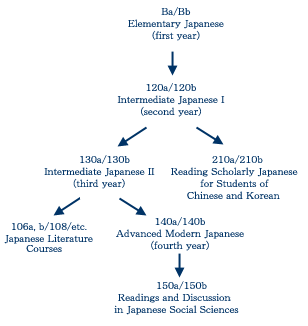Elementary Japanese (Ba and Bb) is designed for students with no previous background in Japanese. This course meets five hours a week—three for lecture and two for drill—and provides a balanced introduction to the four skills of speaking, listening, reading, and writing Japanese. In addition to the hiragana and katakana writing systems, 180 kanji (Chinese characters) are introduced in this course.
Intermediate Japanese I (120a and 120b) builds on the foundation laid in Elementary Japanese to consolidate students' knowledge of the fundamental grammatical structures of Japanese, with an aim to increasing their ability to communicate using natural Japanese in a wide range of situations of daily life. Students are introduced to reading materials of increasing complexity on a variety of topics in traditional and modern Japanese culture. They are taught to read and write approximately 500 kanji (Chinese characters) beyond those introduced in Elementary Japanese.
In Intermediate Japanese II (130a and 130b), students develop skills in reading authentic materials from contemporary Japanese media and fiction and in aural comprehension of contemporary television news and drama with decreased reliance on pedagogical aids. Speaking and writing skills are developed to an increasingly sophisticated level. Approximately 600 additional Chinese characters are introduced beyond those introduced in 120ab.
In Advanced Modern Japanese (140a and 140b), the aim is increased speed and comprehension in the reading of various textual types, with a special emphasis on the accurate understanding of structurally complex sentences. Activities and projects are structured around the reading materials to develop conversation and composition skills to a more advanced level, including oral presentations where students are trained in the appropriate use of formal expressions.
The Department of East Asian Languages and Civilizations offers a variety of courses in Japanese literature of various periods from Heian to modern. Please consult the university catalog for information on these courses.
In Readings and Discussion in Japanese Social Sciences (150a and 150b), students gain experience in the extensive and intensive reading of books and articles by Japanese writers on topics in contemporary Japanese society, politics, and economics. Discussion and lectures are conducted entirely in Japanese. Students are encouraged to integrate their own disciplinary interests with their study of Japanese through a variety of written projects and in-class presentations.
Reading Scholarly Japanese for Students of Chinese and Korean (210a and 210b) is a third-year-level reading course for graduate students specializing in Chinese and Korean studies to develop skills in reading and translating academic genres of Japanese. Special attention is given to secondary sources authored by Japanese scholars on topics of relevance to Chinese and Korean studies. Although the primary emphasis is on modern texts, an introduction to classical Japanese grammar and old kana usage is given in the spring semester to provide students with the ability to read classical forms commonly used in scholarly writing.

